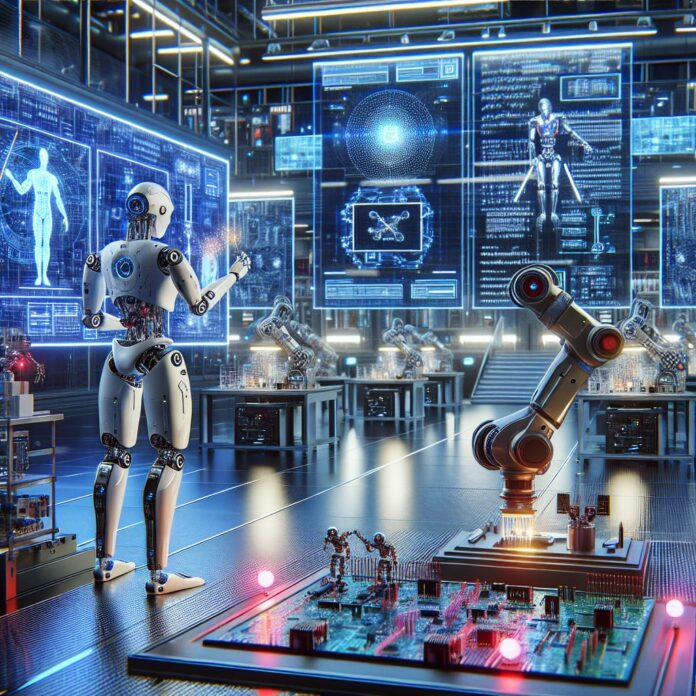In the fast-paced world of aviation, efficiency is key. The integration of robotics in aircraft maintenance, especially through ABB Robotics, is revolutionizing how we approach these essential tasks. From enhancing inspection accuracy to minimizing downtime, the benefits are substantial.
Key Takeaways
- ABB Robotics drastically reduces aircraft maintenance downtime through predictive maintenance tools.
- Machine vision technology by ABB enables defect detection with 22-micrometer accuracy.
- Implementing robotics in maintenance improves safety and precision in servicing aircraft.
- Cost efficiency is achieved by reducing human error and optimizing resource management.
- Robotic solutions are paving the way for future advancements in aviation maintenance.
How ABB Robotics Transforms Aircraft Maintenance
Aircraft maintenance is a critical component of aviation safety and efficiency. Traditional methods, while effective, often come with challenges such as extended downtime and potential for human error. Enter ABB Robotics, a leader in automation solutions, which is transforming this landscape. By implementing advanced robotic systems, maintenance processes become faster, more accurate, and significantly safer.
Optimizing Inspection and Quality Control
Inspection and quality control are pivotal in aircraft maintenance. ABB Robotics utilizes machine vision technology to enhance these processes. This technology allows for precise defect detection, identifying issues with an accuracy of up to 22 micrometers. Such precision is essential in maintaining the high safety standards required in aviation.
“Machine vision-enabled robotic cells can check spots and identify defects at a speed twenty times faster than human inspection.”
Most importantly, this technology not only increases accuracy but also speeds up the inspection process, reducing the time aircraft spend grounded for maintenance. Therefore, airlines can ensure their fleets are operational more frequently, optimizing both time and resources.
Reducing Downtime with Predictive Maintenance
Predictive maintenance is another groundbreaking advancement brought by ABB Robotics. By leveraging AI-driven tools, these systems can predict when components are likely to fail. This foresight allows for maintenance to be conducted proactively, reducing the likelihood of unexpected breakdowns.
Imagine the scenario: an aircraft is scheduled for a routine check, but with predictive maintenance, potential issues are flagged well in advance. This approach not only prevents unscheduled downtime but also extends the lifespan of the aircraft components, leading to significant cost savings over time.
Incorporating these predictive tools ensures that maintenance schedules are adhered to without unnecessary delays, keeping aircraft in the air and generating revenue rather than sitting idle.
Increasing Safety and Precision in Aircraft Servicing
Safety is paramount in aviation, and precision in servicing is crucial. ABB Robotics enhances this aspect by providing robotic systems that handle tasks with exactitude and consistency that human workers might find challenging to achieve. For instance, robotic systems can perform precise drilling tasks, ensuring components are assembled with perfect alignment.
“Autonomous drilling techniques implemented by ABB provide unmatched precision, reducing the risk of human error.”
Besides that, these robotic solutions significantly reduce the risk of workplace accidents, ensuring a safer environment for maintenance personnel. With robots taking on the more hazardous tasks, human workers can focus on oversight and decision-making, roles where human intuition and expertise are indispensable.
Implementation of Autonomous Drilling Techniques
One of the most fascinating developments in aircraft maintenance is the use of autonomous drilling techniques. ABB Robotics has pioneered systems that automate the drilling process, ensuring high precision and consistency. These robots can be programmed to follow exact specifications, reducing the risk of human error. This precision is crucial in aircraft assembly, where even the smallest misalignment can lead to significant issues.
By automating these tasks, maintenance crews can focus on more complex activities that require human oversight and judgment. This not only enhances the overall efficiency of maintenance operations but also improves the safety and reliability of aircraft components.
Integration of 3D Vision for Item Picking and Mobility
3D vision technology plays a critical role in enhancing the capabilities of robotics in aircraft maintenance. ABB’s integration of this technology allows robots to perform complex item-picking tasks with remarkable accuracy. These robots can identify, sort, and handle various components, significantly speeding up the maintenance process.
Imagine a scenario where a robot can navigate through an aircraft’s components, identifying and selecting parts with precision. This capability is particularly useful in environments where space is limited and precision is crucial.
- 3D vision systems enable robots to adapt to different lighting conditions, ensuring consistent performance.
- The technology allows for real-time adjustments, enhancing the robot’s ability to handle unexpected challenges.
- Integration with mobility systems ensures that robots can move efficiently within maintenance facilities.
These advancements not only streamline maintenance operations but also reduce the time and effort required by human workers, allowing them to focus on more strategic tasks.
Case Studies on Efficiency Improvement
Real-world examples provide valuable insights into how ABB Robotics is transforming aircraft maintenance. Several major airlines have already adopted these technologies, witnessing significant improvements in their maintenance operations.
Success Stories from Major Airlines
One leading airline implemented ABB’s robotic systems in their maintenance hangar, resulting in a 30% reduction in maintenance time. By automating routine inspections and component handling, the airline was able to keep more aircraft in service, boosting their operational efficiency.
Another airline reported a substantial decrease in maintenance-related delays, thanks to predictive maintenance tools provided by ABB. By identifying potential issues before they became critical, the airline was able to schedule maintenance during off-peak times, minimizing disruption to their flight schedules.
Comparative Analysis: Manual vs. Robotic Maintenance
When comparing manual and robotic maintenance, the advantages of robotics become evident. Manual maintenance, while effective, often involves longer downtimes and a higher potential for human error. In contrast, robotic systems offer consistent performance and precision, reducing both time and costs.
Consider the task of inspecting an aircraft’s engine. Manually, this process can take several hours and requires a team of technicians. With ABB’s robotic systems, the same task can be completed in a fraction of the time, with greater accuracy and less risk of oversight.
Challenges and Solutions in Robotics Integration
While the benefits of robotics in aircraft maintenance are clear, integrating these technologies comes with its own set of challenges. Understanding and addressing these challenges is crucial for successful implementation.
Addressing High Initial Investment Costs
The initial cost of implementing robotic systems can be significant. However, it’s important to view this investment as a long-term strategy. The efficiency gains and cost savings achieved through reduced downtime and increased precision often outweigh the initial expenditure.
Many companies are exploring financing options and partnerships to mitigate these costs, allowing them to benefit from robotics without straining their budgets.
Overcoming Resistance to Technological Change
Change can be daunting, especially in industries with established practices. Resistance from personnel who are accustomed to traditional methods is a common hurdle. To overcome this, it’s essential to involve teams in the transition process, providing training and demonstrating the tangible benefits of robotics.
By fostering a culture of innovation and continuous improvement, companies can ease the transition and encourage acceptance of new technologies.
Future Prospects for Robotics in Aircraft Maintenance
The future of robotics in aircraft maintenance is bright, with ongoing advancements promising even greater efficiency and precision. Emerging technologies, such as AI and machine learning, are expected to further enhance the capabilities of robotic systems, enabling them to perform increasingly complex tasks.
As the aviation industry continues to evolve, the integration of robotics will play a crucial role in maintaining safety, reducing costs, and improving operational efficiency. Embracing these technologies today will ensure a competitive edge in the rapidly changing landscape of aviation maintenance.
Potential Technological Advancements
The future of robotics in aircraft maintenance is set to be transformative. We can expect advancements in AI and machine learning to enhance the capabilities of robotic systems further. These technologies will enable robots to perform more complex tasks with even greater precision and efficiency. As these systems become more sophisticated, they will be able to learn from previous maintenance activities, improving their performance over time.
Projected Industry Growth and Adoption Trends
As more airlines recognize the benefits of robotics, we anticipate a significant increase in adoption rates. The global aerospace robotics market is projected to grow substantially in the coming years, driven by the demand for more efficient and cost-effective maintenance solutions. Airlines that invest in these technologies now will likely see a competitive advantage, as they can offer more reliable services with reduced operational costs.
| Aspect | Manual Maintenance | Robotic Maintenance |
|---|---|---|
| Time Efficiency | Longer Downtimes | Reduced Downtimes |
| Precision | Variable | High Precision |
| Cost | Higher Over Time | Lower Over Time |
The table above illustrates the stark differences between manual and robotic maintenance, highlighting the efficiency and cost-effectiveness of adopting robotic systems.
As technology continues to evolve, we can also expect to see more collaborative robots, or cobots, being integrated into maintenance teams. These cobots will work alongside human technicians, taking over repetitive tasks and allowing humans to focus on more strategic roles.
Frequently Asked Questions
As the integration of robotics in aircraft maintenance becomes more prevalent, several common questions arise. Addressing these can help clarify the benefits and potential challenges of adopting these technologies.
How does ABB Robotics improve inspection accuracy?
ABB Robotics utilizes advanced machine vision technology to enhance inspection accuracy. This technology enables robots to detect defects with a precision of up to 22 micrometers, far surpassing human capabilities. By automating these inspections, airlines can ensure that maintenance is conducted with the highest level of accuracy, reducing the risk of oversight.
What are the cost benefits of using ABB Robotics?
Implementing ABB Robotics in maintenance operations leads to significant cost savings over time. By reducing downtime and minimizing human error, airlines can operate more efficiently. The initial investment in robotic systems is offset by the long-term savings achieved through optimized maintenance processes.
- Reduced labor costs due to automation of routine tasks.
- Lower operational costs from decreased downtime and fewer maintenance-related delays.
- Extended lifespan of aircraft components due to precise and timely maintenance.
How does predictive maintenance reduce downtime?
Predictive maintenance tools analyze data to forecast when components are likely to fail. By identifying potential issues before they become critical, airlines can schedule maintenance proactively. This foresight allows for maintenance to be conducted during off-peak times, reducing unscheduled downtime and keeping aircraft operational.
What challenges might arise when implementing robotics?
While the benefits of robotics are clear, there are challenges to consider. High initial investment costs can be a barrier for some companies. However, many are exploring financing options to mitigate these expenses. Additionally, resistance to technological change is common, but involving teams in the transition process and providing comprehensive training can ease this transition.
It’s also important to ensure that the integration of robotics aligns with existing maintenance processes. Collaboration between robotics providers and maintenance teams is crucial to address any compatibility issues and ensure seamless integration.
What future developments are expected in this field?
The future of robotics in aircraft maintenance is promising, with continuous advancements on the horizon. We can expect to see more sophisticated AI and machine learning algorithms that enhance the capabilities of robotic systems. These technologies will enable robots to perform increasingly complex tasks, further improving efficiency and precision.
Moreover, the development of more advanced cobots will facilitate greater collaboration between humans and robots, optimizing maintenance processes and improving overall safety. As these technologies become more accessible, we anticipate widespread adoption across the aviation industry.



